2014 Harley-Davidson Touring Motorcycles Review
Project Rushmore: Believe The Hype?
In 2009, in the midst of the recession (or “economic downturn,” if you prefer), executives at Harley-Davidson Motor Company had an epiphany: Just because it’s not broken doesn’t mean it can’t be fixed.
Last weekend at its annual dealer meeting in Denver, Harley-Davidson pulled the wraps off the culmination of that enlightenment: Project Rushmore, a top-secret institutional overhaul that caught even most of its dealers by surprise. On Monday, in a flurry of press releases reported here on Motorcycle.com, Harley announced vast revisions to its Touring line, including a new batwing fairing featuring a state-of-the-art “infotainment” system and a new Twin Cam engine with precision liquid-cooled cylinder heads. Other press releases touted improvements to the Sportster line and a revamped Fat Bob.
Rush, More
The focus of Project Rushmore goes far deeper than just refinements to Harley-Davidson motorcycles. More of a philosophy of production than a line of new products, Project Rushmore entails having a customer-led focus on the products the company creates, making those products better and getting them into the hands and between the legs of its consumers quicker than ever. Recognizing Harley-Davidson’s status as a true icon of American industry, the company knew that it could rely on its fervent and dedicated fan base to push its products to their best, and as a result of numerous worldwide focus groups has reimagined and restructured its entire product development process to inject 21st century ideas and technology into its 110-year old brand.
Harley wanted to be faster to market, so it has streamlined its design and manufacturing to ensure products will make it from concept to reality within three years. Harley has also committed to be more innovative and more technologically focused, implementing exacting engineering requirements on all concepts throughout the production process. As a result of these refinements, H-D claims it now has 30% more production capacity than it did just three years ago, ensuring the company will be able to produce more – and better – products, and get them to the customer more quickly.
So that’s what Harley-Davidson means by “Rushmore.” But what does it mean to the rider? Going forward, it means enthusiasts can expect the effects of Project Rushmore to resonate throughout the H-D product line. For 2014, though, it starts with a reinvigorated line of Touring motorcycles.
Built For The Long Haul
Although it would never admit it, surely Harley felt the pressure of the technology being developed and utilized so effectively by the competition, and decided to bring its Touring bikes up to 21st century snuff. First and foremost, that meant updating the rider interface with modern accoutrements. From the saddle of Harley’s faired tourers including the Street Glide, Tri-Glide trike and new Ultra Limited (basically all but the Road King), the first evidence of this new approach to tech is front and center, in the phenomenal Boom! Box infotainment system.
A full-color touch-screen navigation, communications and audio system, the Boom! Box was developed in conjunction with longtime Harley partner Harman-Kardon. It features the industry’s first voice-command control, meaning with the proper headset and microphone the rider (or passenger) can ask the GPS for directions, make or answer phone calls and select and/or adjust music just by speaking. Conveniently, a rider can also choose to have GPS and phone audio directed into helmet-mounted speakers while his music still pumps from the fairing via the 25 watts per channel audio system.
For those who don’t want to wear a mic/headset, the Boom! Box has a full-color screen. Better, each handgrip console sports a small thumb-activated joystick that allows the rider to scroll through its functions, including displays of whatever valuable vehicle info that’s not shown on the gauges or odometer (air temp, oil pressure, tire pressure monitor where equipped, etc.), without removing hands from the grips. It comes stock in a 4.3-inch version, or you can get a brilliant 6.5-inch model that boasts a nifty touch screen that’s easily actuated with gloved fingers. The big screen is optional on the Street Glide and Electra Glide Ultra Classic but comes standard on the Street Glide Special, Ultra Limited and Tri-Glide.
All in all, it works so well, so intuitively, everyone in attendance in Denver gushed over its performance and interface. By any yardstick, the Boom! combines what are likely the best audio, comm and nav systems we’ve ever encountered on a motorcycle into one standard unit. Genius.
If you’re not a “techie” touring rider, well … sorry kid, but you’re in the minority these days. Look, the tech in effect on most 2014 touring motorcycles is here, and it ain’t goin’ anywhere. So if you want a new Harley tourer but are wary of “infotainment,” you have three options: A) Shut the Boom! Box off and try to ignore its presence (good luck); B) Accept it and learn how to make it work for you (easy enough); or C) Buy a Road King (totally cool).
Stylistically, enhancements to the Touring line range from the aesthetic to the practical, and do a fine job of achieving improvement in both areas. The batwing fairing that encases the Boom! Box looks different – and the reasons for that upgrade serve both its appearance and performance. Its nose has been elongated to provide more of a brow over the headlight and a less stubby look than its predecessor. But that lengthening also serves to drive air up the nose and into the new “splitstream” vent just under the windscreen, which provides a massive reduction in buffeting by force-feeding air to into the pocket created by the fairing.
Taller riders will still likely experience a bit of turbulence, but at 5’11” I couldn’t imagine a scenario when I’d want the vent closed; perhaps in a downpour, but I didn’t have a chance to test that theory. The redesigned batwing is standard on all the new touring models excepting, of course, the Road King.
But these improvements pale in comparison to what’s easily the simplest yet most significant upgrade to the entire line of 2014 Harley Touring bikes: H-D has finally ditched the unwieldy, unintuitive, inconvenient and downright obnoxious outside-mounted latch system on its saddlebags and replaced it with a large, one-touch lever that allows the rider to remain in the saddle while accessing the contents of the saddlebag. Hallelujah! No more getting off the bike and lining up two distinct pieces to get them to seal. The lid opens easily, hinges outward and shuts and latches with a seal you can feel, all from the saddle of the bike. No electronics. No clunky components. No B.S. Simple, elegant, and effective, it’s a 110% improvement over the former system and, to be sure, better than most current OEM saddlebag latching systems.
Mechanically, upgrades to the 2014 Touring line are numerous. Throughout the line, the forks were increased nearly 6 millimeters to 49mm in diameter, providing a stiffer, more stalwart ride. The clutch is now hydraulic, eliminating cables and providing improved performance and lighter feel over past Harleys.
2012 Victory Cross Country Review
The new linked brakes are a wonder. Vastly superior to previous Harleys, the stopping power is more than enough for bikes of this size. The ABS is not jarring or clunky when activated, and the linked function mercifully disables itself below about 25 mph, so slow-speed maneuvers like dragging the rear brake through tight canyon turns present no problems.
Heart Of The Matter
Okay, we’ve put it off long enough. The biggest development from Project Rushmore is the unveiling of the new High-Output Twin-Cooled Twin Cam 103 engine, and a 110-c.i. version that’s available only on the CVO Limited. It’s a big, beautiful piece of machinery. Drowned in the hoopla, however, are a couple of key points.
First of all, the liquid cooled V-Twin is a rather exclusive item. It comes only with the top-of-the-line Electra Glide Ultra Limited and the Tri Glide Ultra. It’s not available on Harley’s most popular motorcycle, the Street Glide, or its new Special sibling; nor does it come on the Road King or even the faired Electra Glide Ultra Classic. Of course, it’s also not (yet) offered on any of the bikes in any of the other Harley lines that have yet to benefit from the Project Rushmore approach, such as the Softails or Dynas. And it’s not available as an option.
So despite the tidal wave of noise from the MoCo about Project Rushmore, its most-ballyhooed offering is available in just three motorcycles in 2014. And one of them’s a trike.
More disconcerting is that much of that noise appears to be a lot of hot air. Whatever benefits the Twin-Cooled system delivers don’t affect the ride in any significant way. From the saddle, it’s not noticeably cooler; Parade Mode still kicks in under super-hot conditions, shutting off the rear cylinder, and the motor still roasts the rider’s right leg and, after a while, rump.
Number two, while Harley claims the new High-Output Twin Cam (liquid-cooled or not) produces 5-7% more power and torque, we couldn’t really feel it. Granted, we were in the Rockies, riding anywhere from 6,000 to 10,000 feet in elevation; still, the fuel-injected TC103 was underwhelming, particularly in the twisties. Granted, bikes such as these aren’t made for throwing around, but canyon-carving should be a blast on most any motorcycle, especially a bagger such as a Street Glide. Too bad it’s not as much fun on the 2014 Harley-Davidson tourers as we hoped. We can only imagine the kind of kick some fresh pipes and a breather kit might deliver.
There’s no reason the Twin-Cooled Twin Cam 103 shouldn’t contribute long-term mechanical benefits like longer oil and gasket life, fewer valve and ring jobs, extended service intervals, etc. However, on the pavement and from the saddle, the advantages of the new liquid-cooled motor are negligible at best, and the grin factor – and, curiously, the trademark Harley ass-rumble – provided by any of Twin Cam 103s seemed sadly subdued.
Still, the ride quality aboard any of the 2014 Harley-Davidson Touring machines is precisely what you’d expect: steadfast and sure, particularly on the avenues and the interstate. The appropriately-named Road King is the monarch of the Touring line. It doesn’t benefit from a fairing or the killer new audio/comm/nav system, but that’s alright; with the Road King, you know what to expect, and the King delivers.
It’s easy to see why the $20,399 Street Glide is the best-selling bike in the entire H-D lineup; it provides wind protection and the convenience of cargo space while still maintaining a cool profile and attitude. Its fairing-mounted, half-moon mirrors are easily the best in the Touring line.
It’s hard to imagine the super Glide will cede much of its segment domination to the new Indian Chieftain, and the addition of the infotainment (gawd I hate typing that) system certainly gives the Street Glide a leg up. Still, we can’t wait to shoot ‘em out.
The new Ultra Limited stakes its claim among the finest touring motorcycles currently in production, and with an MSRP starting at $25,899 it’s no wonder. The LTD features the larger touch-screen, excellent wind protection, accessory plugs for rider and passenger, individually heated seats as well as grips (with a nifty bar-end dial thermostat) and everything else the touring rider could want. And with the Boom! Box, it’s got better electronics than any other touring bike on the market.
Bottom Line
Harley-Davidson execs called Project Rushmore the “most significant new product launch in our 110-year history,” but swallowing that hyperbole as fact is to shotgun the Harley Kool-Aid. The fact is, trailblazing motorcycles like the Nightster and Street Glide are few and far between. More often than not, we get highly stylized bikes such as the Cross Bones and the XR1200 that arrive at the showroom just as their respective bandwagons are leaving the station. We like the concept of Project Rushmore though, and are optimistic its production processes will combine with increased customer input to deliver not only motorcycles but parts, accessories and gear that react to trends faster and get to market quicker.
Here’s hoping the suits at Harley-Davidson never lose sight of what makes motorcycling great, and what makes its brand particularly unique: the visceral rush of performance, and an innate understanding that Harley-Davidson truly belongs to the folks who own, ride and love its motorcycles. And all the infotainment in the world ain’t gonna change that.
Click here to see our complete 2014 Harley-Davidson touring motorcycles gallery
Related Reading
Harley Announces Project Rushmore, Revamps 2014 Touring Line
Harley Reveals Twin-Cooled Engine With Liquid Precision Cooling
2014 Harley-Davidson Sportsters receive ABS And Keyless Security Options
2014 Harley-Davidson Fat Bob Receives Dark Custom Makeover
2014 Indian Chief, Chief Classic, and Chieftain Review
More by Jon Langston



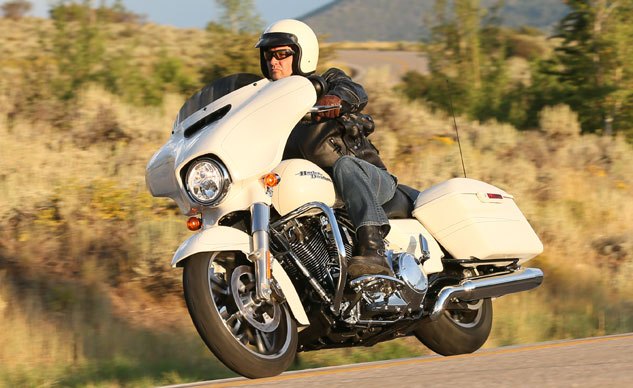
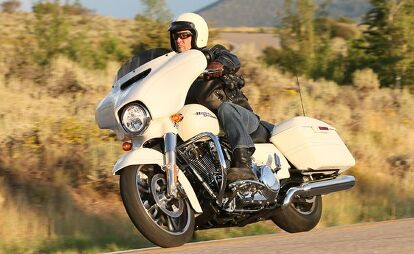





































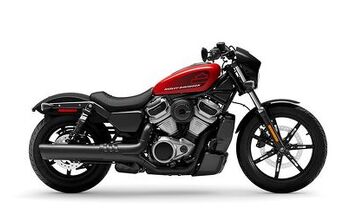
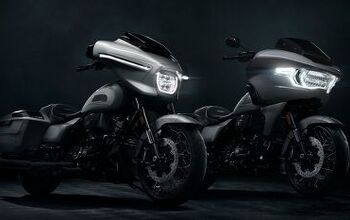
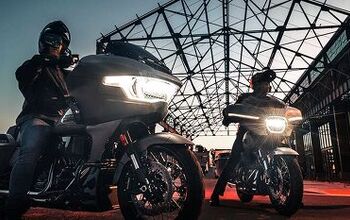














Comments
Join the conversation
I bought an 07 FXD new and still have it... i have done over 70,000kms on it and its been easy to ride goes ok and for what it is comfortable. Its most hi tech attribute is a speedo... simple and love it.
4 weeks ago I bought a TK and love it. The rushmore tech is fun on a trip ( actually fun around town too!) I intend to ride around Australia on it - and cant freaking wait! I did have a couple of minor tech issues when I first picked it up and its sorted now. Great bike cant to do 70.000kms on this one as well.... I have the best of both worlds
Learning curve on the Boom Box everyone. Here is a GREAT resource for learning the Boom Box System! http://www.harleyboombox.com